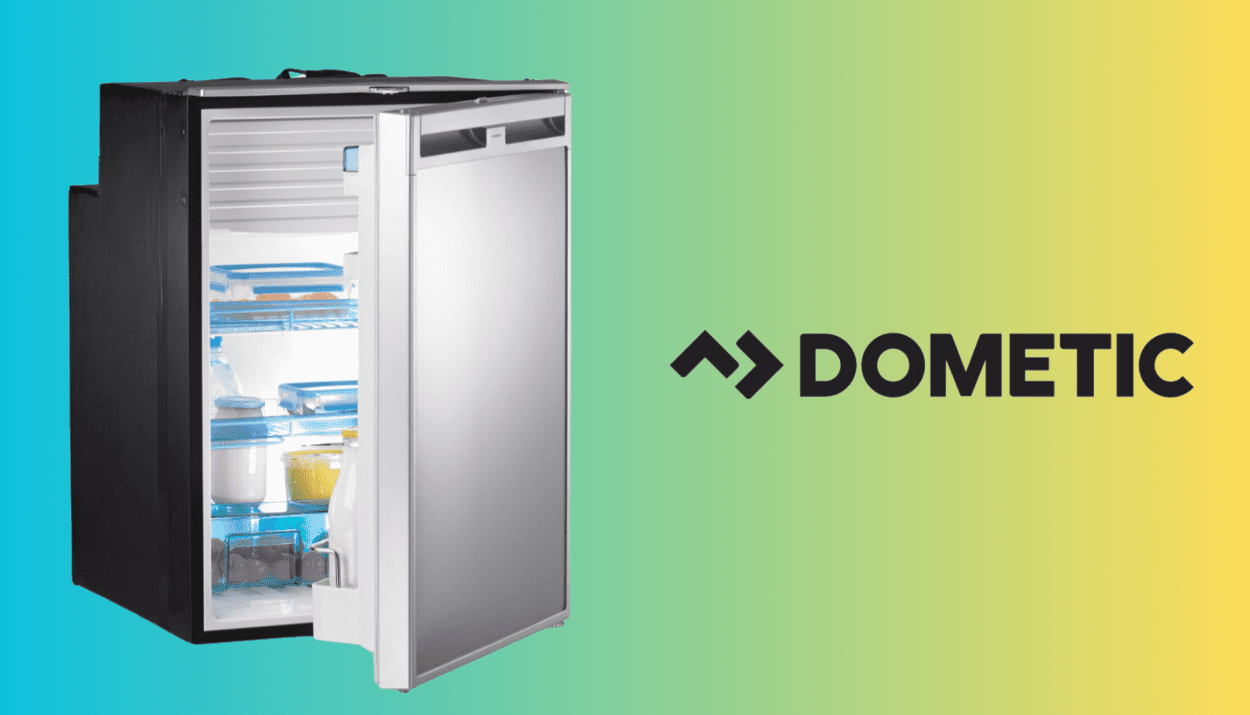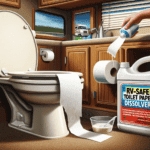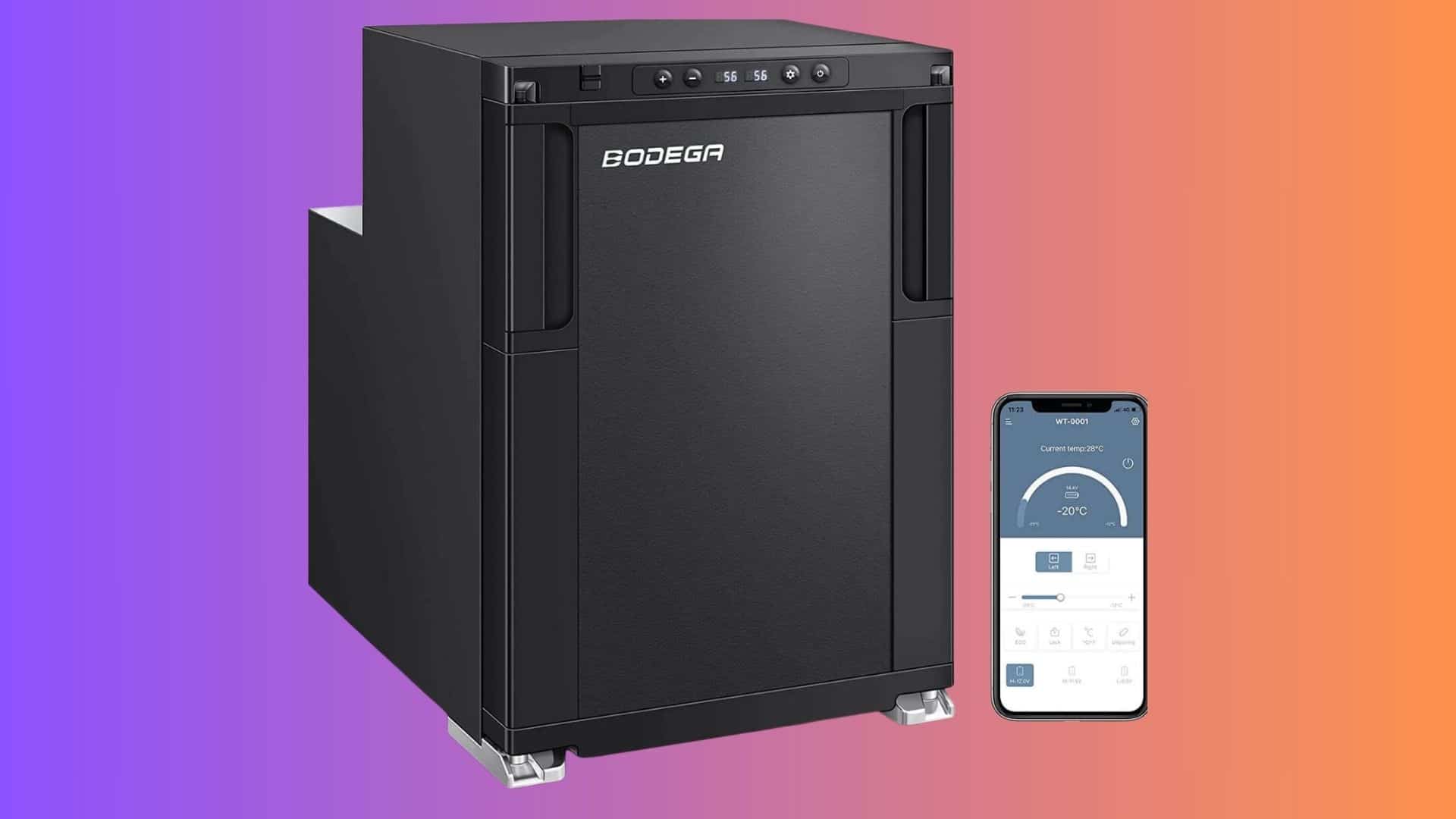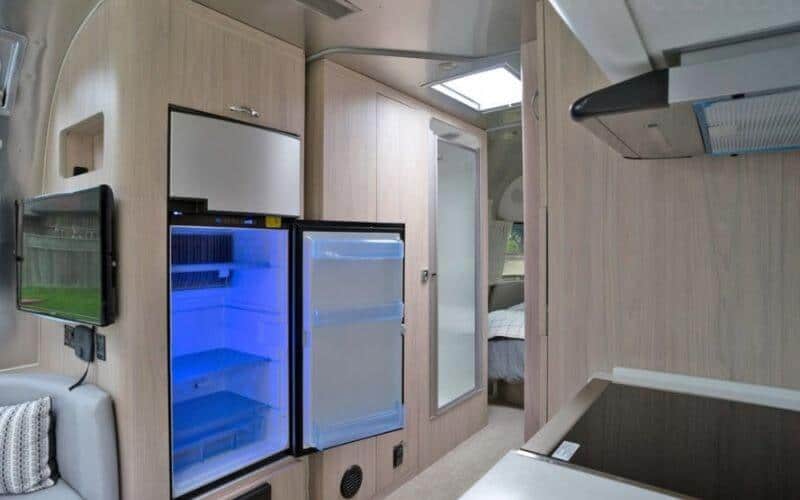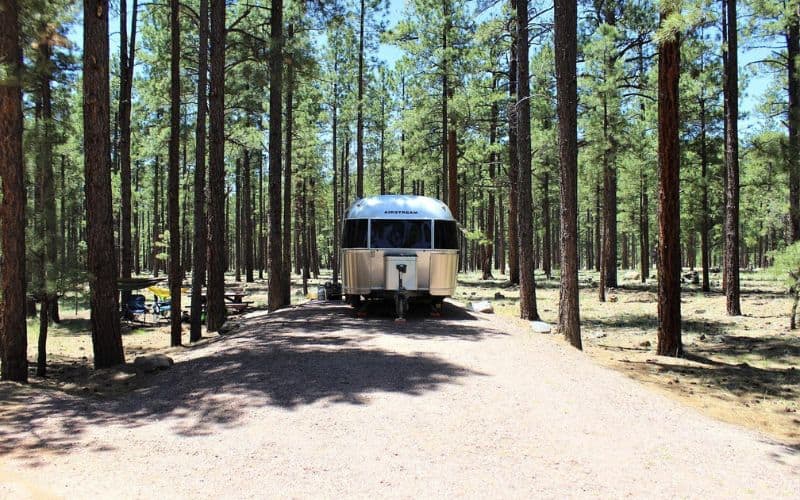Adjusting the temperature on your Dometic RV refrigerator varies slightly depending on your specific model. Some refrigerators have buttons with a 1-5 temperature scale. Others are factory preset and only allow minor temperature tweaks using a manual knob.
I remember the first time I tried to change the temperature in my Dometic RV refrigerator. At first, I cranked the refrigerator temp down as low as possible. It took me a while to finally learn how the Dometic fridge temperature control works.
You don’t have to go through the same ordeal I did. So, in this article, I’ll walk you through the different types of temperature controls found on RV refrigerators, answer some of the most common queries, and provide valuable tips on how to adjust temperature on Dometic RV Refrigerator.
How Dometic RV Refrigerators Work
Dometic RV refrigerators use an absorption process to cool the refrigerator’s interior. This process involves separating a mixture of ammonia and water using heat. The heat source can be electric heating elements or an LP gas flame. The heat causes the ammonia to boil and turn into a gas, while the water remains a liquid.
The ammonia gas flows through a series of coils, where it cools and condenses back into a liquid. This process of boiling and condensing the ammonia removes heat inside the refrigerator, cooling it down.
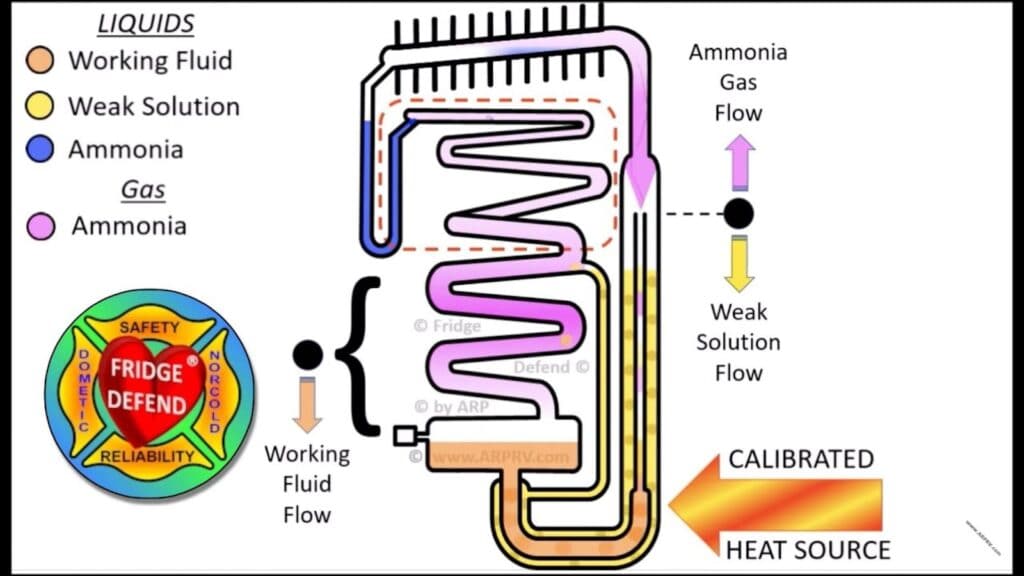
Source
When You Need To Adjust Your Dometic RV Fridge Temperature
Adjust the temperature settings in the following situations:
- Using the Dometic RV fridge for the first time: The ideal interior fridge temperature is around 40°F. Adjust the dial gradually and allow the temperature to stabilize before making additional changes.
- Temperature is too warm: The interior temperature is likely too high if your fridge is not cooling properly, with soft or melting food items. Adjusting the dial to a cooler setting should lower the temperature and better preserve your food items. Check with a thermometer to confirm the new temperature is in the recommended range.
- Temperature is too low: The temperature is too low if food items are freezing inside the fridge compartment. Adjust the dial slightly towards a warmer setting until foods are cold without freezing.
- Outside temperature changes: Significant shifts in the exterior temperature can impact your RV fridge’s interior temperature. When camping in hot or cold weather, adjust the temperature dial according to the exterior conditions.
- The fridge is full: The ideal temperature also depends on how full your fridge is. A heavily stocked fridge will require a colder setting than an emptier one and vice versa.

Source
Adjusting Temperature in Dometic RV Fridges With Buttons
Some Dometic RV refrigerator models have buttoned temperature controls, with buttons ranging from 1 to 5, instead of a manual dial. With these button controls, the available temperature range is more limited. However, you can still fine-tune the setting to suit your needs.
Here is how to adjust the temperature on a Dometic RV refrigerator with buttons:
- Locate the temperature control buttons at the front of the refrigerator.
- Press the buttons to increase or decrease the temperature according to your requirements and allow time for the temperature to stabilize before making additional changes.
- Remember that higher numbers indicate colder temperatures. Setting 5 will be the coldest option.
- I often find that Setting 4 works perfectly to keep food chilled but not frozen. This seems to be the “sweet spot” for most RV owners.
- Try starting at the middle number 3. Monitor the temperature for a few hours. If it is still too warm, adjust it up to 4. If it is too cold, adjust to 2.
- The ideal setting depends on factors like how full the fridge is. For instance, a packed fridge will require a higher cold setting than an emptier one.
With some testing and adjustment, you’ll find the right button setting to keep your Dometic RV refrigerator at just the appropriate chilled temperature.
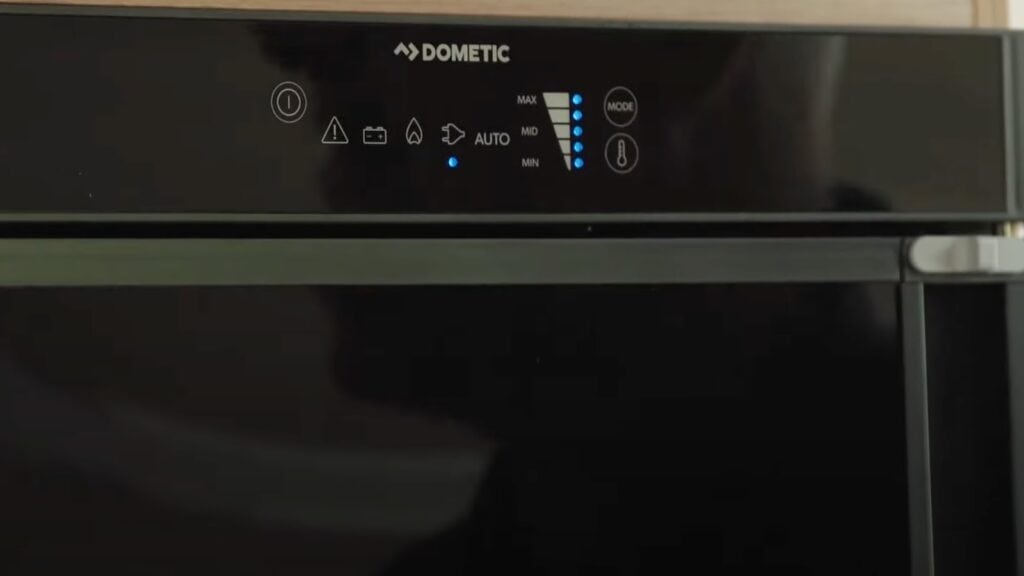
Adjusting Temperature in Dometic RV Fridges Without Controls
Some older Dometic RV refrigerator models do not have adjustable temperature controls. Instead, they rely on a thermistor to regulate temperatures automatically.
The thermistor is a temperature sensor clipped onto the cooling fins inside the fridge compartment. It feeds data to the fridge thermostat, which turns the cooling on and off to maintain target temperatures.
You can adjust the overall fridge temperature slightly by repositioning the thermistor:
- Locate the thermistor clipped onto one of the fridge fins.
- Moving the thermistor upwards makes the fridge cooler. Remember this by thinking that going North will take you to colder regions.
- Lower placement makes it warmer. Remember this by thinking that going South will take you to a warmer region.
- Allow the temperature to stabilize for a few hours after moving the thermistor.
- Check the new temperature with a thermometer. Adjust again if needed.
- Moving the thermistor will change the fridge temperature by around 6-8°F.
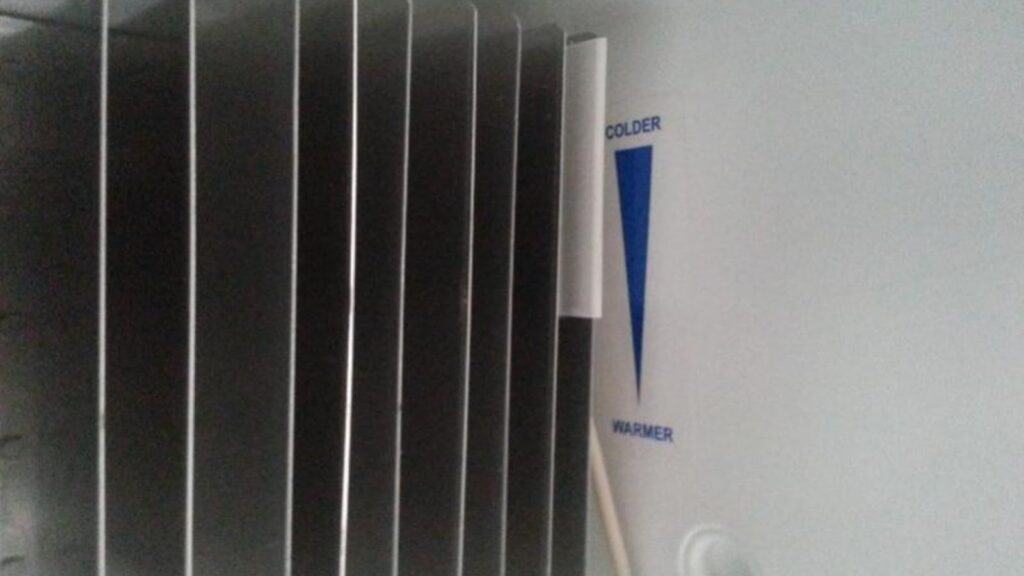
Source
Tips For Efficient RV Dometic Refrigerator Cooling
Properly cooling food and beverages in an RV refrigerator requires special care and attention. A few key tips can ensure your Dometic RV fridge works efficiently to maintain the desired interior temperature. Doing so will save energy and reduce strain on the unit.
- Keep the RV level when parked: Parking on an uneven surface can disrupt the absorption cooling system in Dometic RV refrigerators. The fluids may not circulate properly through the coils, reducing efficiency. Park on a flat, level site so the fridge can work efficiently.
- Ensure good airflow to the exterior vents: Airflow over the condenser coils is critical for venting heat outside the unit. Keep the exterior vents clear of obstructions like insect nests or debris. Good airflow enables the fridge to work with less effort.
- Allow the fridge to cool fully before loading: Turning on the RV refrigerator well before loading food allows the interior to chill to the proper temperature. Starting with an already-cold environment prevents temperature dips when you add food items. Ideally, switch on and let the fridge get cold for 24 hours before filling it with food.
- Install an interior air circulation fan: A small DC muffin fan can circulate the air inside an RV fridge to maintain an even Dometic fridge temperature from top to bottom. Consistent cold air flow over stored food is vital for optimal cooling.
- Avoid overloading the refrigerator: Too much food prevents cold air from properly circulating and makes the fridge work harder. Leave some space inside so the cooling system is not overloaded or strained.
- Minimize opening the door: This one’s a no-brainer. Opening the door frequently allows cold air to escape and warm air to enter. Only open when necessary to take items out or put items in. Keeping the door closed as much as possible saves energy and provides better cooling.
- Use accessories to enhance cooling: Vent covers, interior fans, and thermometers tailored to RV fridges can help optimize airflow and monitor interior temperature. Such accessories lead to more efficient Dometic fridge temperature control.
If your fridge is still not getting cold, read more here.
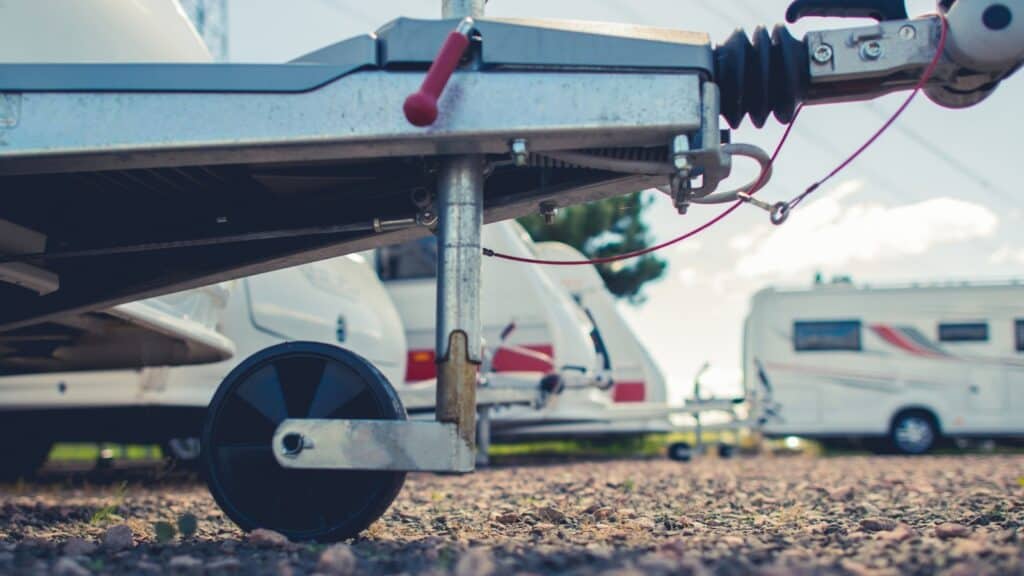
Just so you don’t get lost in the technicalities, here is a table summarizing all the major details I’ve covered till now:
| Adjusting Temperature in Dometic RV fridges with buttons | Higher button numbers indicate colder temperatures Try starting at mid-range Number 3 Make small adjustments and allow time for the temperature to stabilize The ideal setting depends on the external temperature and how full the fridge is. |
| Adjusting temperature in Dometic RV fridges without controls | Older models use a thermistor instead of controls. A thermistor is a temperature sensor clipped inside the Dometic RV fridge.Repositioning it up makes the fridge cooler. Repositioning it down makes the fridge warmer. Allow the temperature to stabilize after moving the thermistor. Can adjust temps approx. 6-8°F. |
| Tips for efficient Dometic RV refrigerator cooling | Keep RV parked at ground level. Ensure good airflow to exterior vents. Allow the fridge to fully cool before loading food. Install a small interior circulation fan. Avoid overloading the refrigerator. Minimize opening the door. Use accessories for better Dometic fridge temperature control. |
FAQs
What is the recommended temperature for a Dometic RV fridge?
The optimal temperature range for a Dometic RV refrigerator is 35-42°F (1.6-4.4°C). Aim to keep the interior around 40°F for proper food safety and to prevent spoilage. This allows cold enough temperatures without freezing items.
How do I adjust the temperature on my Dometic RV fridge?
To change the temperature, look for a small white plastic knob or lever on one of the interior fins. Gently move this knob up to make the fridge colder or down to make it warmer. Alternatively, in Dometic fridge models with buttons or a digital meter, you can choose a level from 1 to 5. Make adjustments in small increments and allow time for the temp to stabilize.
How can I tell if my Dometic fridge temperature is too cold or hot?
Place an appliance thermometer inside the RV fridge to monitor the exact temperature. If it’s warmer than 42°F, adjust the knob to make it cooler. If it is colder than 35°F, adjust it to slightly warmer.
What is the normal temperature range for a van refrigerator?
The standard interior temperature for a van refrigerator typically ranges from 35-40°F. However, optimal temperature depends on the specific refrigerator model, capacity, and outside ambient temperatures. Check the manual for your particular van fridge.
How long does a Dometic RV fridge take to cool down?
A Dometic RV refrigerator can take 4-24 hours to cool down to safe food storage temperatures. The time depends on the fridge’s starting temperature and capacity. Allowing 24 hours for the fridge to chill is recommended, especially in hot weather. This ensures the interior reaches the ideal 35-40°F before you load in food items.

